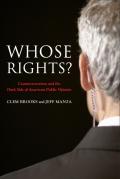Here are links to some of the interesting social science research we encountered during the week:
 In their RSF book Whose Rights? Counterterrorism and the Dark Side of American Public Opinion, sociologists Clem Brooks and Jeff Manza present fascinating new data on what Americans think about the counterterrorism agenda put in place after the 9/11 terror attacks. Their evidence comes from three national telephone surveys conducted between 2007 and 2010; their surveys included embedded experiments that sought to track whether key factors -- information about a hypothetical terrorist attack, for example, or national identity cues -- affected attitudes towards policies like torture or stricter airport security. Below are three broad conclusions, along with explanatory excerpts from Brooks and Manza's book:
In their RSF book Whose Rights? Counterterrorism and the Dark Side of American Public Opinion, sociologists Clem Brooks and Jeff Manza present fascinating new data on what Americans think about the counterterrorism agenda put in place after the 9/11 terror attacks. Their evidence comes from three national telephone surveys conducted between 2007 and 2010; their surveys included embedded experiments that sought to track whether key factors -- information about a hypothetical terrorist attack, for example, or national identity cues -- affected attitudes towards policies like torture or stricter airport security. Below are three broad conclusions, along with explanatory excerpts from Brooks and Manza's book:
1. 'Threat Priming'
A theorem of classical social psychology is that the successful deployment of threats tends to generate highly illiberal and rights-restricting responses on the part of individuals. Threat is often easy to manipulate and more motivating than simple fear. Our experiments complement this scholarship in two ways. First, with respect to time, our results extend previous estimates with new survey data and experiments spanning the years 2007, 2009, and 2010. Second, using comparatively modest experimental cues—typically involving a single-sentence reference such as “What if the government was responding to a terrorist act that had just taken place?”—we find significant impacts on survey responses.We have been struck by the strength of the threat results on both counts. [...] As we discussed in chapter 4, threat primes are the single largest effect in experiments in which they are deployed. We have also been surprised by the magnitude of such impacts in 2010, nearly a decade after the original 9/11 effects. Far from declining in efficacy, threat priming appears remarkably potent.
2. American Citizenship [We] find novel evidence for the operation of national identity as a significant lens through which Americans view policy. In our experiments, when respondents are primed to think that American citizens are the target of coercive policies, support tends to decline significantly. Similarly, an alternative cuing of policy targets as foreign nationals tends to raise support. We find the American public gives priority to their own rights and liberties but shows far less willingness to extend protections to the rest of the world’s citizens. This underlying restriction is notable in its own right and parallels rather provocatively the far greater rights violations meted out to foreign nationals in the war on terror.
Experimental cues involving national identity characteristics operate the same among whites and nonwhites and among self-identified Christians versus others. Even more telling evidence comes from our experiments manipulating the national identity status of a key insider group (Christians) and a second outsider group (people from the Middle East). So powerful is the impact of U.S. citizenship status that its experimental manipulations can prompt respondents to display indistinguishable affect toward these two initially polar groups. Under experimental conditions, Christians who are not U.S. citizens now elicit the same degree of emotional warmth as people from the Middle East who are U.S. citizens. American citizenship status, in short, is remarkably important as such, and not just as a cover for other, different identity attributions.
 Jane Waldfogel is a professor of social work and public affairs at Columbia University School of Social Work. She has written extensively on early childhood education and the impact of public policies on child and family well-being. In this interview, she discusses President Obama's recent proposal to expand access to preschool.
Jane Waldfogel is a professor of social work and public affairs at Columbia University School of Social Work. She has written extensively on early childhood education and the impact of public policies on child and family well-being. In this interview, she discusses President Obama's recent proposal to expand access to preschool.
Q: In response to President Obama's preschool plan, many opinion writers pointed skeptically to Head Start, the major federal early education program. It seems to be settled fact in Washington that Head Start, to quote TIME's Joe Klein, "simply does not work." Others argue that most of the other research on early education comes from targeted, intensive programs, such as the Perry Project, whose quality will probably not be replicated in scaled-up efforts. So let me ask you -- do you think that available research supports higher investments in early education programs? Is there evidence or unanswered questions that gives you pause about expanding preschool access?
A: While policymakers in Washington have been debating the merits of Head Start, and the generalizability of the early model programs such as Perry, state lawmakers have been quietly moving forward with universal pre-kindergarten (pre-K). These pre-K programs, which now serve more than 20% of 4-year olds, differ from Head Start, and the early model programs, in some very important ways. First, they are universal – they are open to all children in the community (although when resources are limited, states do try to serve disadvantaged children and communities first). And second, they are administered and supervised by the schools (even if not always located at schools – in some states, community-based providers can be approved as pre-K providers as long as they meet the pre-K requirements, which include highly qualified teaching staff and approved curricula). This quiet pre-K expansion has been going on for some time, and we now have quite a bit of evidence about its effects (see review in Ruhm & Waldfogel, 2012). That evidence is clear – children who have the opportunity to attend pre-K enter school with better reading and math skills, and these effects tend to be largest for the children who would otherwise be the furthest behind. These results come from studies in several states, using rigorous methods such as regression discontinuity analyses. Governors and state legislators are familiar with this research evidence, and they have been eager to expand pre-K programs. But it’s tough to do this with limited state funds. So that’s why the Obama initiative to make federal funds available is so welcome.
 Projecting how long you think you will live is a crucial exercise in retirement planning. An estimate of life expectancy could determine, for example, your savings rate, a portfolio allocation, or whether or not you should buy an annuity. The standard theoretical model predicts that individuals make unbiased estimates of their life expectancy based on personal, relevant information, such as family history, illness, lifestyle choices, and so on. But a new paper, funded by our consumer finance working group, suggests that life expectancy estimates can be, at least in part, also affected by irrelevant context factors -- in this case, the way survey questions are worded.
Projecting how long you think you will live is a crucial exercise in retirement planning. An estimate of life expectancy could determine, for example, your savings rate, a portfolio allocation, or whether or not you should buy an annuity. The standard theoretical model predicts that individuals make unbiased estimates of their life expectancy based on personal, relevant information, such as family history, illness, lifestyle choices, and so on. But a new paper, funded by our consumer finance working group, suggests that life expectancy estimates can be, at least in part, also affected by irrelevant context factors -- in this case, the way survey questions are worded.
For their newly published article, John W. Payne, Namika Sagara, Suzanne Shu, Kirstin C. Appelt and Eric J. Johnson conducted experiments in which they asked half of the respondents to provide probabilities of their living to a certain age, and the other half to provide probabilities of their dying by a certain age. Ostensibly, these questions are asking the same thing, but the results yielded a surprising result: Those given the "live-to" question reported significantly higher chances of being alive at ages 55 through 95 than those who answered the "die-by" question. In fact, in the first two surveys, which included nearly 2,000 respondents, the mean life expectancy was 8.68 years higher in the live-to frame than the die-by frame.
